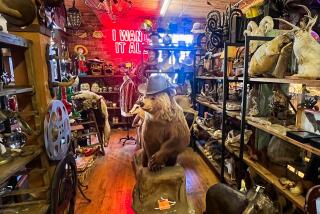Where westerns were in the saddle
With its daily menu of westerns, the Hitching Post Theater in 1940s Hollywood gave posses of kids some early lessons about law and order — and not just on the screen.
“Check Your Guns at the Box Office,” a sign commanded the youngsters, who usually showed up in costume.
Management was serious about cap-gun control.
“They could check to see if your holsters were empty,” said Hollywood historian and Hitching Post habitue Bruce Torrence.
Still, some young desperadoes managed to smuggle their shooting irons into the seating area, as became evident.
“During chase scenes or gunfights on the screen, they would fire off the cap pistols to the tune of yells, whoops and cheers,” said Westell Rhodes, another patron.
As a transplanted New Yorker, Rhodes said, “I had never seen anything like this.”
The Hitching Post, he recalled, “showed a western double feature, cartoons and a serial chapter every day. The exterior had a western theme. The ticket-seller was dressed in cowboy garb.”
Rhodes, in his early teens, quickly shed his New York ways.
“I felt right at home walking down Beachwood Drive dressed in authentic western style with the boots, striped gambler riding pants and cowboy hat,” he said. “Nobody gave me a second glance as I walked about two miles to the Hitching Post.”
It was before Hollywood became obsessed with making one-size-fits-all movies, and genre theaters were plentiful.
Some offered only foreign language films, some silent movies, some newsreels, others sophisticated, art-house attractions. (Soft porn emporiums wouldn’t arrive until the 1960s, followed by, well … you know.)
And then there was the Hitching Post with its sagebrush sagas. Smaller studios in the neighborhood of Gower Street and Santa Monica Boulevard (nicknamed Gower Gulch) were churning out low-budget, B movies. The stars were such luminaries as Roy Rogers (“King of the Cowboys”), Bob Steele (“Two Fisted Hero of the West”) and Gene Autry (“America’s Favorite Singing Cowboy”). One stallion, Rex the Wonder Horse, even got top billing in his own movies.
The Hitching Post opened in 1941 at 6262 Hollywood Blvd., now a plaza outside the Hollywood/Vine Metro Red Line station.
Times columnist Lee Shippey found it ironic at the time that the theater was located near the corner of Hollywood and Vine, “the very heart of what many persons think the center of a sink of immorality.”
But, he noted, the heroes were keeping to the straight and narrow.
“They never smoke, drink, swear, gamble or make love to any but the right gal,” Shippey wrote. (“Make love” meant “chastely kiss” in the 1940s.)
The movie house was such a hit that its owner, ABC Theaters, opened other Hitching Posts in Beverly Hills (later the Beverly Canon theater), Pasadena, Long Beach and Santa Monica. One fan insists that the Santa Monica theater had an actual hitching post outside.
Cowgirls were not so much in evidence at the theaters.
Writer Lisa Mitchell had a girlfriend who said of her infatuation with Hopalong Cassidy: “I didn’t know whether to be his girlfriend or be him.”
For Mitchell, at the age of 9, the choice was easy.
“I had a Hopalong Cassidy outfit with black pants and black shirt,” she said. “I’d wear a cowboy belt with fake jewel studs, a silver buckle and a steer head on the buckle, and a straw cowboy hat. I wore my braids up under my hat so people would think I was a boy. I loved being the girl in the all-boys club.”
Occasionally, when a movie such as “Indian Agent,” with Tim Holt, would seem to suggest an alternative costume, some moviegoers would show up as Native Americans, with feathers in their hair.
The mostly male-oriented audience did not thrill to the warbling of Roy Rogers and Gene Autry.
“I remember the noise and popcorn bag-throwing during the singing or love scene between the cowboy star and the banker’s daughter,” Morley Helfand wrote on the Cinema Treasures website.
The good guys had no trouble fighting off the black hats. What they couldn’t handle was the invasion of television sets in the early 1950s.
Suddenly, the little buckaroos had only to go into their living rooms to flip a switch for entertainment instead of trudging, or catching a ride, to a movie house.
One by one, the L.A.-area Hitching Posts shut down. The Hollywood prototype became the Paris Theater in November 1949.
“It’s amazing that it could stay alive that long, and in such a good locale,” Mitchell said.
When the Paris Theater opened, The Times wrote, “You’d never know the old place. Instead of the horsey atmosphere, everything is now plush and chichi, as lobby and auditorium smile with flowers, ferns and sophisticated murals.”
Flowers, ferns, murals? Chichi?
You could almost hear Rex the Wonder Horse snorting, “Neigh!”
More to Read
Start your day right
Sign up for Essential California for news, features and recommendations from the L.A. Times and beyond in your inbox six days a week.
You may occasionally receive promotional content from the Los Angeles Times.






